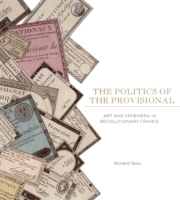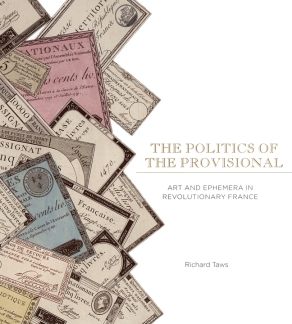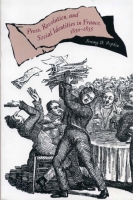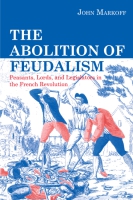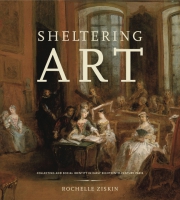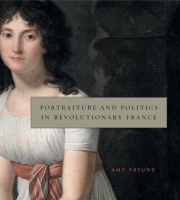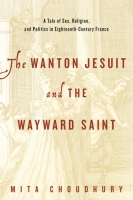The Politics of the Provisional
Art and Ephemera in Revolutionary France
Richard Taws
“The Politics of the Provisional engages with several historiographies within the sprawling subject of the French Revolution. It is very difficult to find a really original take on just about any aspect of the Revolution, but Richard Taws does. This is quite a feat.”
- Media
- Description
- Reviews
- Bio
- Table of Contents
- Sample Chapters
- Subjects
Publication of this book has been aided by a grant from the Millard Meiss Publication Fund of the College Art Association.
The Politics of the Provisional was shortlisted for the R. H. Gapper prize, an annual prize given by the Society for French Studies to the best work in French Studies.
The Politics of the Provisional is the first book in the Art History Publication Initiative (AHPI), a collaborative grant from the Andrew W. Mellon Foundation. Thanks to the AHPI grant, this book is available on a variety of popular e-book platforms.
“The Politics of the Provisional engages with several historiographies within the sprawling subject of the French Revolution. It is very difficult to find a really original take on just about any aspect of the Revolution, but Richard Taws does. This is quite a feat.”
“What Richard Taws offers is a series of concepts with which to frame French Revolutionary visual culture: to the notion of the provisional, he adds currency, identity, circulation, temporal rupture, media transgression, and mimetic dissimulation. Not only are the arguments and formal analyses moored to original material, but they are so cogently structured that it is hard to see them as anything but convincing. Art historians have much to learn from the approach Taws takes. He renders an entire realm of images and objects foundational to our understanding of the production, status, and meaning of representation in the 1790s—and, in so doing, he develops models for thinking about the relation of the visual to political upheaval more generally. This is one of the most sophisticated accounts of material culture I have read.”
“This brilliant and profoundly original book makes us see the French Revolution with new eyes. Richard Taws is emerging as one of the major new voices in writing about the French Revolution and visual politics in general.”
“Richard Taws’s The Politics of the Provisional: Art and Ephemera in Revolutionary France makes a compellingly original contribution to the study of the visual and material culture of the French Revolution. . . . [It] succeeds in opening up new avenues of inquiry for scholars of the eighteenth and nineteenth centuries interested in the ways that provisionality was both an effect of the Revolution’s upheaval as much as it was a mode of confronting its contingencies.”
“[Richard Taws’s] book is packed with a wealth of theoretical insights, with borrowings from Benjamin, Bakhtin, Baudrillard, Freud, Taussig, De Certeau and Rancière. But this flexible conceptual apparatus is always grounded in meticulous close analysis and abundant archival research. The Politics of the Provisional is not only an exceptionally beautiful book, courtesy of the team at Pennsylvania State University Press; it is also an extremely important one for any scholars inquiring into the historicity and the modernity of the French Revolution.”
“This book is both extremely well researched and theoretically daring, illuminating careful readings of primary texts with methodologies reaching beyond Taws’s field of art history into revolutionary studies, psychoanalysis, and anthropology. . . . Taws lays the groundwork for a way of doing history that relies neither upon the forced application of theory to a historical period nor upon the simple adoption of a linear progression of time that prevents the contradictions and complexities of a particular moment from emerging. Moreover, The Politics of the Provisional will be indispensable for architectural historians seeking to understand how structures of impermanence are equally central to issues of memory, history, and modernity as their more lasting counterparts built in stone, iron, and concrete.”
“The field of vision of French Revolutionary studies has been greatly expanded by Richard Taws’ pioneering study in The Politics of the Provisional: Art and Ephemera in Revolutionary France. . . . Taws’ incisive arguments surrounding the objects of his study are made all the more convincing by a sophisticated command—and articulation—of the technical processes, and the attendant challenges, involved in their production, most especially in the case of printmaking. Not only does this lend veracity to the at times necessarily imagined scenarios of citizens’ encounters with revolutionary ephemera, it also anchors the compelling theorisation of the images and objects at hand.”
“Taws does what all great art historians should do—he changes the way we look at objects we already know, and opens our eyes to objects we have overlooked, or indeed that we have never seen before. The Politics of the Provisional is a field-changer. Taws’s arguments, moreover, will have implications far outside of the field of art history; his book will also transform the way that historians and political theorists think about images.”
“Provocative and pioneering. . . . In an age when newspapers are giving way to tweets, Taws has written a disquieting meditation on the nature of the modernity bequeathed to us by the eighteenth century.”
“[This] book by Richard Taws is by far the most demanding and ambitious study to date of these diverse Revolutionary objects. . . . Timely and important.”
“Succeeds as an exposition of the ephemeral art of the Revolution due to Taws’s imaginative choice of objects to be analyzed, his meticulous examination and perceptive analysis of the many, often obscure, features of this art, and his ability to weave his discoveries into a sophisticated and original argument that expands current understanding of the relationship of revolutionary culture to the politics of the Revolution.”
Richard Taws is Lecturer in the History of Art Department, University College London.
Contents
List of Figures
Acknowledgments
List of Abbreviations
Introduction
1 Made of Money: Transparent Bodies, Authentic Values, Paper Signs
2 Between States: Passports, Certificates, and Citizens
3 Revolutionary Models/Model Revolutionaries: Architecture, Print, and Participation at the Festival of the Federation
4 Performing the Bastille: Pierre-François Palloy and the Memory-Work of the Revolution
5 Material Futures: Marking Time in a Revolutionary Almanac
6 Paper Traces: Playing Games with the Revolutionary Past
Conclusion
Notes
Bibliography
Index
Introduction
At midday on 5 May 1793, a crowd gathered on the Place de la Bastille in eastern Paris to observe a solemn and unmistakably revolutionary ritual. In front of several revolutionary legislators, hangers-on, and assorted observers, workers unearthed a large wooden box that had been buried in the center of the Bastille site less than a year earlier, on 14 July 1792, the third anniversary of the storming of the prison. Installed beneath a stone from the Bastille by the builder-entrepreneur Pierre-François Palloy, the demolisher of the prison and a self-styled “patriot,” the container comprised part of the foundation for a monument to liberty that was proposed for the site but that never, in fact, saw the light of day. The box functioned as a kind of time capsule, for it contained a motley assortment of objects, all of which provided material evidence of the sweeping political and social changes brought about by the Revolution. Although it might be expected that these objects were vestiges of the Ancien Régime, in fact few of them predated the Revolution itself, while those that did had been remade as overtly revolutionary.
Included in Palloy’s box were an assignat, or paper banknote, of fifty livres and several coins of varying values; four medals made from the chains of the Bastille, representing the ci-devant king, his ministers, and the deputies of both the Constituent Assembly and the Legislative Assembly; and a copper-bound copy of the Constitution of 1791 (fig. 1). In addition, a bronze plaque engraved with the Declaration of the Rights of Man and of the Citizen and the Constitution, a portrait of Louis XVI (who had been executed on 21 January 1793, just over three months before the box was unearthed) carved into another Bastille stone, and effigies of the legislators Jean-Sylvain Bailly and Claude-Emmanuel de Pastoret were also packed into this underground casket. Following earnest speeches by the future consul Jean-Jacques Régis de Cambacérès and the deputy Louis-Joseph Charlier, the politically outmoded contents of the container were excavated by order of the National Convention, and, in a reenactment of the demolition on the same site in 1789, they were smashed to pieces beneath the “national hammer” by the same Palloy who had put them in place the previous year.
Yet despite the iconoclastic rhetoric that governed this event and the ritualized erasure of the recent past it set in play, these objects were not simply destroyed. Instead, their bruised remains were piled back into the same cedar box and transported immediately to the National Archives, founded three years previously, where they were placed under the guard of the chief archivist Armand Gaston Camus. Conspicuously but not irretrievably damaged, these obsolete fragments remain there to this day. The Bastille site, on the other hand, remained empty, despite the hopes for a future characterized by the production and display of effective and enduring symbolic objects that were no doubt in the air that spring day in 1793. It was not until 1840 that it received its permanent monument in the form of a column commemorating the Revolution of 1830.
Revolutions are forced to do stuff with debris, to sort and reframe not only the leftover remnants of the regimes they set out to destroy but the outdated, embarrassing evidence of their earlier selves. Becoming a revolutionary, to steal a phrase from the historian Timothy Tackett, required the production, and more pressingly, the reproduction, of things. This tale of revolutionary uncertainty regarding the Revolution’s historical legacy was not an isolated incident but was typical of attempts to use material objects to narrate and, more importantly, to actively constitute transformations in the temporal and political order of 1790s France. Such responsiveness to the contingencies of the historical process came to typify revolutionaries’ self-conscious performance of their unique situation in time. While it is tempting to read the exhumation of Palloy’s memory-box as indicating the inability of its contents to secure the Revolution’s “meaning,” longevity is not the only way in which objects acquire currency. Rather, this book will argue, visual practice in revolutionary France was characterized by the production and circulation of a range of transitional, provisional, ephemeral, and half-made images and objects, whose frequently uncertain, fleeting, or makeshift materiality paradoxically provided the most effective ongoing means of negotiating the historical significance of the Revolution.
Occupying a nebulous space between, and overlapping with, the traditional prerogatives of divinely ordained kingship and the new social order of nineteenth-century modernity, France in the 1790s was characterized by frequent shifts in political authority and an embrace of the new that regularly ran up against a persistent desire, shared by revolutionaries of all political orientations, to complete the Revolution. The prospect of revolutionary permanence (if not “permanent revolution”) was a difficult one to realize, the stabilization and perpetuation of the Revolution requiring a delicate combination of stasis and ongoing incompletion. Throughout the 1790s revolutionaries recognized the potential for art to negotiate this impasse, and the call for the production of enduring monuments, paintings, and public spaces dedicated to the memory of the Revolution came from all points on the revolutionary political spectrum. This was often framed in terms of a perceived distance from the ephemeral displays, dissimulative feints, masquerades, and intrigues considered typical of both Ancien Régime political culture more generally and the bourgeois art and elite luxury objects that dominated the market in eighteenth-century France.
However, the radical destabilization of systems of patronage and display that accompanied the momentous events of 1789 had engendered massive changes in the conditions under which artists worked. Shortages of materials and money, combined with a volatile political atmosphere, meant that it was increasingly difficult for painters, sculptors, and architects to carry on as they had before the Revolution. Duration was not easily achieved, and few large-scale artworks or projects for lasting monuments were ever completed, although many were proposed. With some notable exceptions, the space was filled with the production of transient, ephemeral installations, often made for festivals or other revolutionary commemorations, as well as a wide range of new kinds of visual production that the Revolution had either initiated or transformed. These included the eclectic output of official and nonofficial print publishers—calendars, almanacs, paper money, identity cards, newspapers, bureaucratic vignettes, laws, forms, caricatures, playing cards, portraits, songs, topographies, and images of revolutionary events—alongside numerous other souvenirs, relics, paintings, drawings, plans, clothing, and furniture. They provided multiple opportunities for artists and other cultural producers to work in newly straitened circumstances and, often, to experiment in a manner that would not have been possible previously.
In portraying the Revolution as “a sort of lacuna, a deserted and sterile space for the history of art,” Antoine-Chrysostome Quatremère de Quincy, the antiquarian and neoclassical theorist responsible for the conversion of the Panthéon, that monument to the persistence of memory, set the tone for the subsequent reception of much revolutionary visual practice. Although the diversity of revolutionary art has long been recognized, a focus on a few elite artists has contributed to the persistence of a surprisingly tenacious set of assumptions about the indifferent quality of revolutionary artistic practice or, worse, the Revolution’s status as an outright negation of art. With some notable and influential exceptions, art history has tended to isolate for discussion a few key oeuvres from this period, privileging in particular the work of Jacques-Louis David and his students. While I am aware of crucial differences in production and use, my aim is not to reinforce the distinction between this kind of institutionally valorized art and the images and objects once described by Linda Nochlin as “an odd assortment of second-rate portraits [. . .] historiated toby jugs and indecipherable coarse-grained prints.” On the contrary, in examining how revolutionaries attempted to reconfigure their understanding of society, politics, and history via an engagement with the mechanics of transience, it is crucial that we pay attention to how demonstrably “artistic” works intersected with a diverse field of images conventionally understood to be outside the sphere of art.
David and other academic painters were also, undoubtedly, implicated in the politics of provisionality, and not just in terms of a diversified practice that led to such artists designing everything from playing cards and letterheads to clothing, festivals, and theater sets during these years. Take, for instance, David’s 1794 painting of the child-martyr Joseph Bara (fig. 2), a work that for reasons both intentional and happenstance claims a middle ground between the past and future, between two incompatible regimes, between male and female, between childhood and adulthood, and between life and death. All of this is rendered in a feathery, irresolute brushwork that breaks down into hazy formlessness at the borders of the image, applied to a canvas that was intended to be paraded through the streets at a revolutionary festival that was planned in full but that never took place because of the downfall of the political regime whose ideology of self-sacrifice it supported. David’s work exemplifies, perhaps more than any other painting, the political stakes of provisionality in 1790s France. It demonstrates the extent to which constructions of subjectivity, gender, revolutionary politics, and artistic style were all subject, in different but overlapping ways, to the unpredictable effects of the Revolution’s adamant forward drive. However, the belatedness of the painting, its fall into obsolescence before it had the opportunity to realize its purpose, and its teetering position between utopian future and revolutionary history only tell us part of the story of how provisional images and objects could be more than the outmoded wreckage of discontinued political systems.
Indeed, the vast majority of visual materials that conveyed the Revolution’s symbolic message around France, whether issued by the state or private interests, were mobile, ephemeral, and multiple. Despite the revolutionary desire for permanent monuments equal to those of Rome or Greece, it was assignats, passports, games, caricatures, certificates, posters, souvenirs, clothing, and engravings—precisely the kind of things that made their way into Palloy’s container—that played the greatest role in transmitting visually the message of the Revolution, although not always in ways that were readily understood or easily managed by either their producers or their multiple consumers. Added to these were the rituals, performances, and impromptu spaces of display, exchange, and forgery, which were even more provisional in nature. As the story of Palloy’s box on the site of the Bastille shows, the visual culture of the Revolution could at various points provide the bedrock for the historical imagination of the Revolution and at the same time be subject to radical and regular revision.
It is a central claim of this book that the temporary character of much of the Revolution’s material culture is not best understood as a sign of the failure of revolutionaries to produce images and objects of lasting importance. On the contrary, it points to a dynamic, contradictory process of experimentation that had profound implications for how revolutionaries became constructed as political subjects. Widely reproduced, ephemeral, “in-between” images and objects made during the French Revolution were, I argue, a primary site for the formation of both individual subjectivities and wider national or political community identities, and they were at the heart of debates on the nature of political authenticity and historical memory. Usually, of course, permanence was the desired outcome, of both revolutionary politics and visual production—witness the enthusiasm for a monument at the Bastille. However, the means by which permanence could be achieved were not straightforward and were regularly undermined by material, economic, and political constraints. As provisional images began to lose their meaning or value, or were recycled, destroyed, sequestered, or decommissioned, revolutionaries (and those with alternative political affiliations) were forced to think tactically about corporeal, political, and material legitimacy and, in so doing, to consider their relationship to the new ways of understanding time initiated by the Revolution. Thinking about material durability was one of the key ways in which revolutionaries thought about duration, and it was consequently crucial to how they imagined the place of the Revolution in history.
In short, provisional images and objects had currency as producers of meanings that played an active role in shaping their world. Many of these works were explicitly “useful” objects, made for functional rather than overtly aesthetic ends. Operating in the here and now of the political present, some were necessarily conceived as flexible and evolving, a means to an end, while others came to be considered provisional only after their passing. These images and objects, most of which were produced in quantity, were often made in full consciousness of their status as commodities. The currency of these works, which was, in many cases, inseparable from their status as currency, resided too in their ability to circulate—as reproduced items that could be owned, transmitted, or viewed by a critical mass of individuals— and in their potential to operate as mediums of both change and exchange.
Rather than provide a comprehensive inventory of revolutionary visual culture or long-since-vanished objects (an impossible task in any case), The Politics of the Provisional is an attempt to assess critically the visual politics of revolutionary France. The studies on which each chapter is based draw out distinct and conflicting themes within the political and visual culture of the period, interrogating an archive that is layered, heterogeneous, and contradictory. For reasons of coherence I have concentrated for the most part on images produced in Paris, where the majority of existing images were produced, sold, or legislated for; although at several points this has been neither possible nor desirable, and I am conscious that Paris does not stand for the Revolution as a whole. While ordered thematically rather than chronologically, the book focuses on a conventional “revolutionary decade” from 1789 to 1799, with some porosity at either end, yet it goes without saying that the narrow historical frame provided by conventions of date limitation is, while seductive, potentially misleading. This is all the more apparent in the context of a temporally complex process such as the French Revolution, whose origins are found long before the storming of the Bastille and whose significance expands well beyond it.
Despite the claims made for them by revolutionaries, almost all of the objects discussed in this book had significant precedents earlier in the eighteenth century, if not before. Few scholars would now subscribe to a reading of the French Revolution as a rupture so absolute that it obliterated all signs of the recent past, and I certainly do not wish to lay claim to a reading of the Revolution as a fully autonomous, coherent historical unit. Rather, the question of how revolutionaries dealt with continuities, both from the previous regime and from earlier moments in the history of the Revolution, is at the core of this book. However, alongside these broader historical shifts, it is essential that we acknowledge the specific temporalities of the works under discussion. Material objects are complex things that have histories of their own. Even the most transient, fragile objects tend to stick around for some time. In fact—and this paradox is at the heart of any analysis of the “ephemeral”—these objects that fall apart or are destroyed in great numbers often turn out to be as durable as their ostensibly more secure counterparts, for they are amenable to preservation in both personal collections and state archives.
In many cases, the objects I discuss—money, identity documents, and festivals, for instance—all became more formalized in the Napoleonic period than during the First Republic, increasing in worldwide importance with the rise of industrial capitalism and the nineteenth century’s cycle of revolutions. None of this would have been possible, however, without the first French Revolution’s eagerness to “regenerate” its symbolic language and all areas of administration, art, and ritual. Producers of revolutionary images may have drawn upon long-standing visual traditions when making their works, but that does not mean these images were mere recapitulations of all that had gone before. Continuities yes, but ruptures too. Paper money may have preceded the Revolution, but the assignat was something quite new. A long tradition of royal and religious festivals undoubtedly informed revolutionary festivals, but not one of them commemorated a revolution. Ex-votos and relics were medieval in origin, but Palloy’s Bastille relics were singular to their historical moment. Almost every culture in history has had its fair share of transient, interim, or speculative images and objects, but in France in the 1790s they took on a heightened significance as the very substance of the Revolution. As much as any artwork, these objects deserve examination in the historically specific context of their production and use.
While the provisional has been frequently taken to stand for the degraded ephemerality of the Ancien Régime—not least during the Revolution itself—since the early nineteenth century it has also signified the effervescent transience of a modernity the Revolution arguably brought to realization. Over a decade before Victor Hugo’s fictional description of how “in the provisional France made the eternal,” Charles Baudelaire had conceptualized modernity, in his famous essay on Constantin Guys, as “the transitory, the fugitive, the contingent, the half of art whose other half is the eternal and the immutable.” Baudelaire began this essay with a reflection on how the work of Philibert-Louis Debucourt, an artist discussed at length in chapter 5, was particular to its historical moment. By 1863 Debucourt’s work was interesting to Baudelaire precisely because of its “pastness,” much as modern art was of value for its “essential quality of being present.” Yet although the dialectical character of modernity that Baudelaire outlined certainly seems to speak to the works under discussion here, we have good reason to be cautious of simplistic readings of the Revolution’s modernity. Indeed, it is crucial to recognize that, despite a widespread contemporary recognition of the Revolution’s unprecedented breach with the past, its aftereffects were often not anticipated by those responsible for it, newly politicized subjects whose expectations, ideas, and forms of expression were those of the eighteenth century. Nonetheless, the Revolution did transform inexorably the relation between made things and the political field, not least because, as Richard Wrigley has astutely observed in his study of revolutionary dress, it marked an ill-defined crossroads between a world where nothing was thrown away and a world of modern consumerism where obsolescence, transience, and disposal were intrinsic to the status of the object.
Consequently, each chapter of this book figures as a conjuncture where a set of images comes into focus, often from a mass of similar or related images. Indeed, in many cases, the very excess of these images has paradoxically limited their visibility as objects of study. Received as either functional objects outside the terrain of “art” or as art objects that address transient subject matter, these images are susceptible to a banal marginalization as “ephemera.” Yet these normative, unitary categories of “revolutionary visual culture” or “ephemeral art” have failed to account for the interactions between such forms of representation and other more established media and genres, from Academic history painting to sculpture or architecture. Moreover, as indexes of a political field that was itself far from stable, these images remind us too that binary separations between “revolutionary” and “counterrevolutionary” image making are limited in their usefulness, as such positions were far from fixed and were the product of processes of struggle and appropriation between politically varied and inharmonious groups. This book works from an assumption that any history of revolutionary visual culture demands a reading of counterrevolutionary visual production, and that the two were at all points mutually constitutive categories.
What is at stake here is a politics of the provisional that is less about tracking shifting allegiances on a neat spectrum between royalist and Jacobin than it is about visuality itself as a form of political praxis. Despite the ostensible marginality of much of the material dealt with here, many of the images in the chapters that follow were produced by the state or were images that responded to or reflected administrative transformations of the political structure. Recognizing the power dynamics and genre hierarchies of so-called ephemeral works allows us to complicate notions of “high” and “low” in artistic practice. However, the reception of such images was neither straightforward nor uncontested. While the production of images in large quantities by the revolutionary legislature gives us a good idea of what successive governments desired to make known or change in the French people, at points it also allows us access to how people responded to the revolutionary state and what they recognized or subverted in the images made in their name. Forging and folding, attaching and adapting, collecting and carrying, remodeling and renaming were all strategies by which citizens could transform the function and appearance of the images and objects they encountered. Carefully scratching the ink away from the paper of a letterhead to reflect a change in political authority—in one example, issued at Nevers in messidor year III, “la mort” has been replaced by “la justice,” while “imperisable” has been crossed out altogether (fig. 3)—may have prolonged the existence and utility of the document, but it also exposed how works could change over time and recorded the interaction between individuals and images. By engaging with visual culture, public spectacles, private entertainments, or state bureaucracy, revolutionaries of all convictions situated themselves in relation to revolutionary politics. This had a historical dimension that was apparent from the start of the Revolution but that intensified as it progressed and that exceeded the boundaries of France itself, as colonial subjects also occupied a critical stance with regard to the images and objects of the metropolitan Revolution.
It is perhaps unsurprising then that historians have, with some notable exceptions, sometimes been more willing than art historians have been to engage with this diverse body of material, although their focus has for the most part leaned toward printed images representing prominent revolutionary episodes or symbols. There has also been a tendency among some historians to use images as illustrations of event- or value-based narratives rather than addressing the role of images in the construction of those narratives. However, Lynn Hunt, writing in a fall 2009 issue of French Historical Studies that reflected on the state of revolutionary studies twenty years on from the bicentennial (a time when many important publications and exhibitions appeared), argues that the study of images may be one of the most productive future directions in French revolutionary studies, as it might provide us with ways of understanding how “people came quite literally to see the world differently.” In particular, Hunt suggests we develop new ways of thinking about subjectivity and the social through the examination of multiple rather than individual images. With that in mind, this book attempts to provide a set of criteria for thinking about the visual culture of revolutionary France that moves beyond what it represented into issues of how it represented and what that representation made possible (or impossible). In doing so, this book necessarily casts a wider net than the printed material that has been the primary focus of much important work conducted by scholars including Hunt, Claudette Hould, Joan Landes, Rolf Reichardt, and Hubertus Kohle, arguing instead that the precariousness of representation in revolutionary France was constituted on an intermedial field of exchange between a range of different kinds of objects and images.
The book begins with an analysis of the revolutionary assignat. A bond based on the value of “reclaimed” clerical land, the assignat operated as a national currency until 1796. Situating the assignat against other forms of visual production, from caricature to history painting, as well as the counterfeits that challenged its authority, I examine how the materiality of the paper notes proved a testing ground for the authenticity of other kinds of representation. Considerations of this sort had an effect on subjects as well as objects, and in chapter 2 I examine the precarious interactions between citizens and their printed papers. Focusing on passports, certificates, and other documents, I investigate the ways in which they articulated belonging and exclusion, often understood in terms of evolving racial, gendered, or class-based typologies.
The theme of mobility is developed further in chapters 3 and 4, which also explore differences between provisionality in two or three dimensions. Chapter 3 examines prints representing the first Festival of the Federation, held in Paris on 14 July 1790. Printed images provided a means of negotiating the problematic destruction or recommissioning of the ephemeral structures erected for the festival and a way of rendering permanent the performative, mobile aspect of the event. Chapter 4 focuses on Palloy’s transformation of the ruins of the Bastille, in particular his production of souvenir objects recast in the shape of the prison. These troubling objects engage head-on with the issue of revolutionary time, the subject of chapter 5, which concentrates on revolutionary calendars and almanacs, in particular a single color print by Philibert-Louis Debucourt. Chapter 6 returns to the assignat and a series of trompe l’oeil prints published in the aftermath of the notes’ destruction in 1796, many of which contained hidden silhouette profiles of the executed royal family or prominent revolutionaries in the negative space surrounding other objects. I argue that these images, which track a history of the Revolution through its paper traces, are a response to revolutionary trauma, and consider how motifs of ruin, chance, and dissimulation permeated postrevolutionary discourse.
The final two chapters engage most explicitly with processes of historical imagining and recollection, prediction and recall, and are characterized by an effacement of these differences in trompe l’oeil and other illusionistic techniques, where the blurring of material and temporal boundaries organized both the promise of a revolution to come (Debucourt’s Almanach national in 1790) and the remembrance of a revolution past (the representation of assignats in 1796 and 1804). Images such as these demonstrate the extent to which past, present, and future were not mutually exclusive categories in 1790s France but frequently intersected with one another and often did so within the same image.
The Politics of the Provisional sets out to mediate these antagonistic positions, examining how, short on time and money, revolutionary artists and legislators developed ad hoc, tactical forms of provisional representation that provided new ways of imagining and performing political agency. The Revolution’s evident historical tensions can illuminate our understanding of revolutionary visual culture, but this visual culture also sheds light on the historical process itself. In looking at how the people of the Revolution “saw things,” we have often ignored the objects that made them most aware, on a daily basis, of the ambiguities presented by the visual and of their own precarious positions as spectators. Thinking seriously about revolutionary visual culture demands that we engage with the rich variety of things made to be seen that did not explicitly reference locatable, identifiable revolutionary events and themes, providing comfortable “illustration” for the historical narrative, but that we think too about the contingent, the multiple, the marginal, and the central, the nonfigurative, nonart, nonrevolutionary. How, we must ask, did authentic “revolutionariness” develop through the appropriation of prerevolutionary material? How was visual culture, in its broadest sense, implicated in what it meant to be “postrevolutionary,” as far as such a term may be thought to be meaningful? In revolutionary France, we know, everything was rethought—viewed through the lens of the Revolution, all aspects of life were reimagined, and even familiar objects and practices acquired new resonances. Given this temporal (not to mention political) instability, how could revolutionaries tell the difference between what was “true” and what was “false”?
Authenticity and its close counterpart, transparency, became terms of increasing significance for people, ideas, and things in 1790s France, although their meanings were far from stable, for they required recourse to criteria, inherited from the past, that were no longer available or useful. Reproductive media in particular—but not only prints—worked to broker the relationship between the past, present, and future, securing the authority of new concepts and practices in some instances and challenging them elsewhere. These images and objects, at once asserting truth claims through repetition and undoing them by their unfixed relationship to a single standard of legitimacy, soon became so much outmoded, curious debris, yet they materialized the radical reformulation of time the Revolution had engendered and pointed toward new ways of imagining the future.
Also of Interest
Mailing List
Subscribe to our mailing list and be notified about new titles, journals and catalogs.
